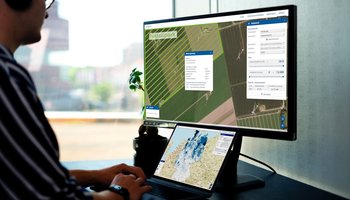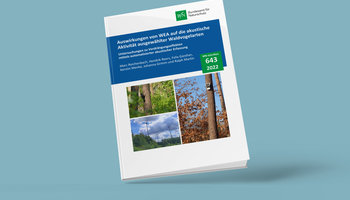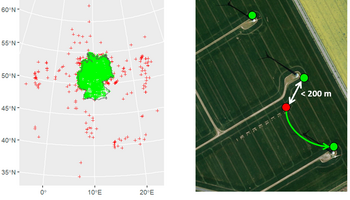The project aims to include non-governmental nature conservation organisations to a greater extent in the national expansion of the network. The project includes approaches such as guidelines and workshops for associations.
Decisions on the expansion of infrastructure corridors as part of the national expansion of the grid are initially made at the level of federal sectoral planning. As this level represents the important planning stage, the most environmentally compatible version of the infrastructure corridor should be identified in the federal sectoral planning process. However, it is primarily local knowledge that is required to identify areas with conflicts or those with fewer risks at an early stage. So it is imperative to conscientiously implement the legally prescribed public participation process (Section 9 of the Grid Expansion Acceleration Act [NABEG]).
Public interest parties, associations and private individuals can seldom ensure an in-depth examination of what are anyway complex and often supra-regional plans. This is why a high level of support and coordination on the part of nature conservation associations is urgently required at national level. The project will investigate the actual conflict potential of five selected grid expansion projects as well as instruments for the future participation of the associations.
The five grid expansion projects will be defined in cooperation with the funding provider and based on information from the Federal Network Agency and the TSO. This choice depends on the start of the planning process and its progress. Gaining and organising cooperation in the regional associations and with volunteers will be defined depending on geographical involvement. Using volunteering allowances and grant agreements, capacities will be created to run information events by the network operators and authorities, examine environmentally relevant designs in network operator contracts and provisions by the relevant authorities, and give advice for the research framework and the environmental assessments (EIA/SEA), especially on species and bird protection and the landscape. Information will also be collected and various points of view and proposals for solutions discussed at association workshops, which will be timed to coincide as closely as possible with the expansion planning. They will be held close to the infrastructure corridor project and will be organised by the Nature and Biodiversity Conservation Union (NABU) with the help of the regional offices.
The results will then be collated into guidelines for each of the projects and recommendation sheets and made available to the associations, regional and federal authorities and network operators. A database will be developed for associations (and authorities) to provide a quick insight into possible impacts on nature conservation resources. This database, along with model comments, will generally simplify the associations' participation for the network expansion measures.
The project enabled the NABU to provide specialist support for the federal sectoral planning of five projects and to support the NABU regional associations in preparing statements on the individual projects. By incorporating the regional associations it was possible to include the suggestions and concerns of nature conservation in the plans at an early stage. The process benefited from the fact that the NABU national association organised the involvement of the local technical experts for ten of the German regions and made the contact to the relevant planning authorities. The willingness of the planning authorities to explain the technical data as well as the openness of most to a discussion on conflicts motivated the associations to enter into constructive cooperation. Topics discussed were the necessary scope of inspection, planning compromises and legal and technical limits for electricity grid projects. Thanks to these early-stage discussions, it was possible to contribute to a legally compliant and environmentally compatible approval at the federal sectoral planning level.
It became clear that acceptance was increased if the project developers and approval authorities treated nature conservation issues sensitively during planning and participation. Examples of this are the extent of the corridor search areas, the number of varieties of corridors or underground cable sections and the use of particular types of masts. It was demonstrated that some project developers use the entire evaluation scope of the SEA for possible options, both for planning new structures and for plans in existing infrastructure routes. On the other hand, other planning authorities – especially under regional planning powers – remain firmly focused on existing routes, even though they may cause concern from the point of view of the associations and require a corresponding adaptation. This in turn influences the associations' view on active participation and cooperation: depending on the degree to which planning and participation are open and forward-looking or more defensive and conservative.
The project worked with five network expansion projects. The sample nature conservation assessments were collated in five guidelines:
A set of instructions and a model statement were developed in order to support nature conservation associations in stating their opinion on specific electricity grid expansion projects. These contain text blocks that can be adapted as required. This means that individual statements can be drawn up with comments on particular locations:
NABU (Nature and Biodiversity Conservation Union)
Department of Nature Conservation and Environmental Politicy
Charitéstr. 3, 10117 Berlin
Sebastian Scholz
Phone: +49 30 284 984 1617
sebastian.scholz(at)nabu.de
Eric Neuling
Phone: +49 30 284 984 1812
eric.neuling(at)nabu.de
Tina Mieritz
Phone: +49 30 284 984 1611
tina.mieritz(at)nabu.de
Federal Agency for Nature Conservation (BfN)
Konstantinstr. 110, 53179 Bonn
15.02.2023
Weiter

13.02.2023
Weiter

11.10.2022
Weiter
